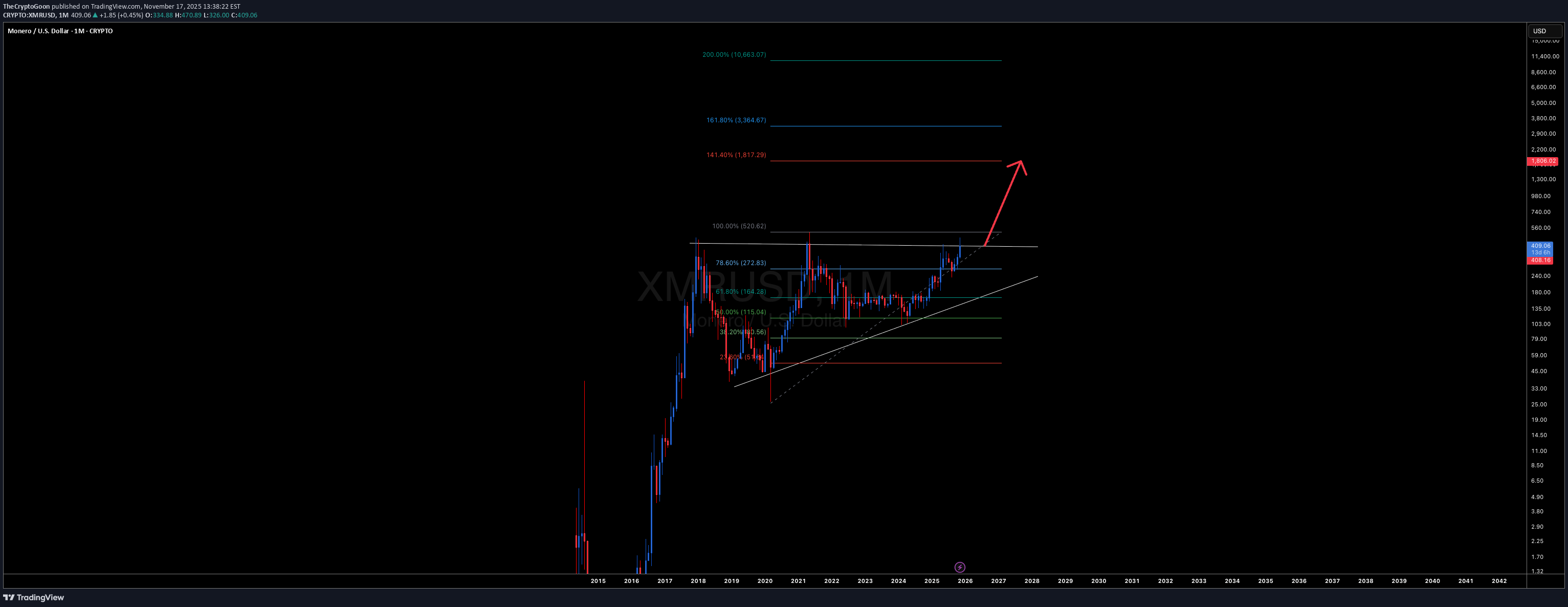
XMR
Monero
| تریدر | نوع سیگنال | حد سود/ضرر | زمان انتشار | مشاهده پیام |
|---|---|---|---|---|
 tradecityproRank: 5524 | خرید | حد سود: تعیین نشده حد ضرر: تعیین نشده | 11/8/2025 | |
 ColdBloodedCharterRank: 34684 | خرید | حد سود: تعیین نشده حد ضرر: تعیین نشده | 11/15/2025 | |
 CryptoNuclearRank: 34697 | خرید | حد سود: تعیین نشده حد ضرر: تعیین نشده | 11/15/2025 | |
 The_Alchemist_Trader_Rank: 34833 | خرید | حد سود: تعیین نشده حد ضرر: تعیین نشده | 11/5/2025 | |
فروش | حد سود: تعیین نشده حد ضرر: تعیین نشده | 11/22/2025 |
Price Chart of Monero
سود 3 Months :
خلاصه سیگنالهای Monero
سیگنالهای Monero
Filter
Sort messages by
Trader Type
Time Frame

iMoneyTeam
سیگنال فروش/شورت مونرو (XMR) در تایم فریم ۴ ساعته: فرصت ورود با مدیریت ریسک!
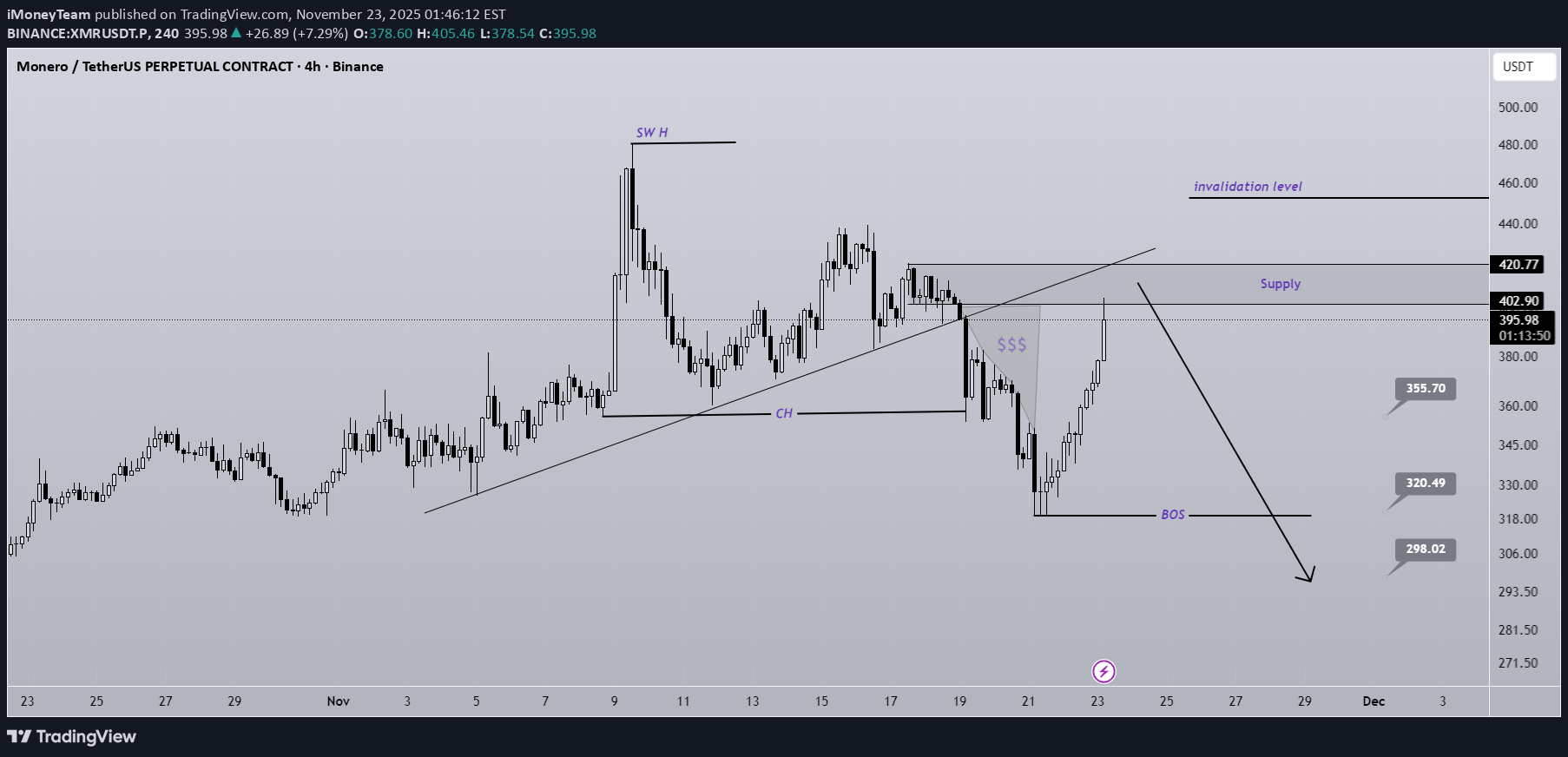
XMR has turned bearish after the change of character (CH) and, following the break of the short-term trendline, has now pulled back to a resistance zone while also sweeping a liquidity pool above the pivots. With proper risk management and adherence to the stop-loss, this setup can be entered. Targets are marked on the chart. A daily candle closing above the invalidation level will negate this analysis. Do not enter the position without capital management and stop setting Comment if you have any questions thank you
سیگنال فروش فوری: مونرو (XMR) در مسیر سقوط تا کجا؟ (ریسک به ریوارد عالی)
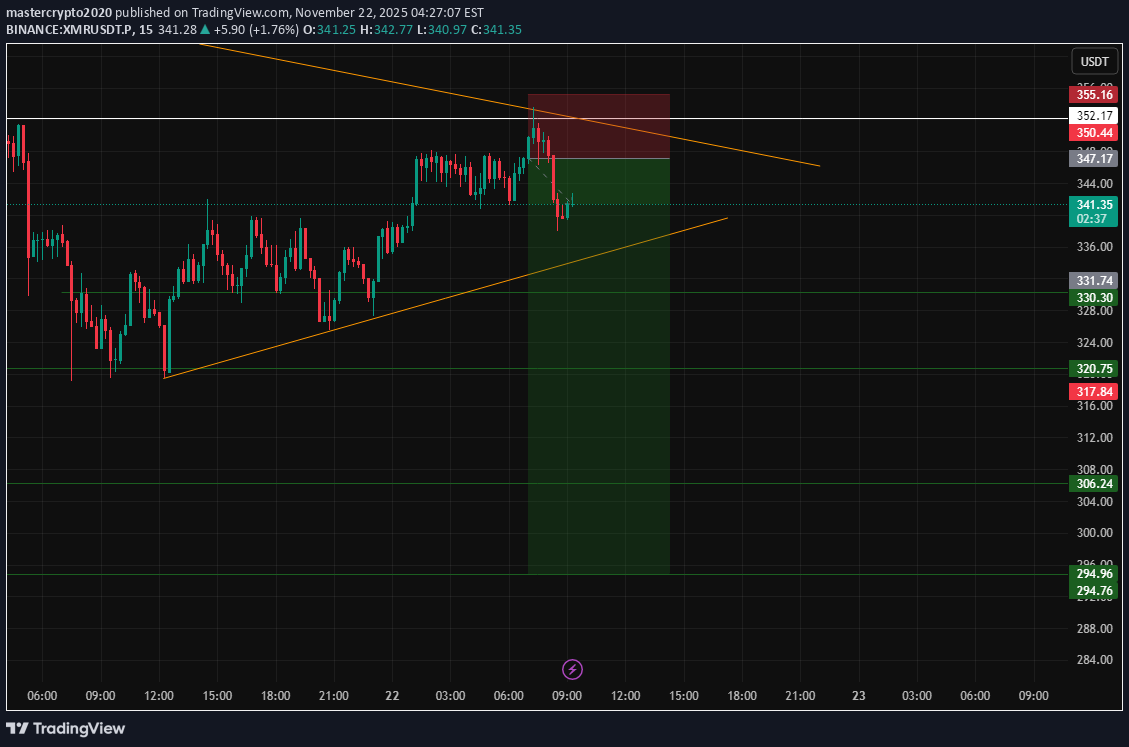
📢 Official Trade Signal – XMR/USDT 📉 Position Type: SHORT 💰 Entry Price: 346.41 --- 🎯 Take-Profit Targets (Partial Exits) TP1 = 330.30 TP2 = 320.75 TP3 = 306.20 TP4 = 294.96 TP5 = — TP6 = — --- 🛑 Stop-Loss: 355.50 📊 Timeframe: — ⚖️ Risk/Reward Ratio: 6.53 💥 Suggested Leverage: 5× – 10× --- 🧠 Technical Analysis Summary Monero (XMR) has reached a key supply zone near 345–355, where sellers historically showed strong control. Price is showing clear bearish reaction, with weakening bullish momentum and a shift toward lower-high structure. A short setup is supported by: Bearish rejection wicks near major resistance Breakdown of intraday support zones Momentum loss on higher timeframes Formation of bearish divergence indicating potential reversal Liquidity resting below 330 – ideal magnet zone Targets are placed on major liquidity pools and untested demand zones, matching institutional flow behavior. --- ⚙️ Trade Management Rules ✔️ Take partial profit at TP1 ✔️ Move Stop-Loss to Break-Even after TP1 hits ✔️ Trail SL downward as price approaches TP2 → TP4 ✔️ Do NOT re-enter if SL at 355.50 is hit ✔️ Avoid emotional trading if price consolidates around entry --- ⚠️ Important Risk-Management Note After TP1 is reached, ALWAYS move SL to Entry Price (346.41). This turns the trade into a risk-free setup. ❗ If price hits TP1 then reverses and closes at Break-Even → this is NOT a loss. Capital preservation is the foundation of professional trading. --- 📌 TradingView Hashtags #XMRUSDT #Monero #CryptoSignal #ShortSetup #TechnicalAnalysis #TradingView #FuturesTrading #ALTCOINS #ScalpTrade #ProSignal --
تحلیل موجی مونرو (XMR): سقوط زیر ۳۵۰ دلار و هدف بعدی ۳۱۶ دلار!
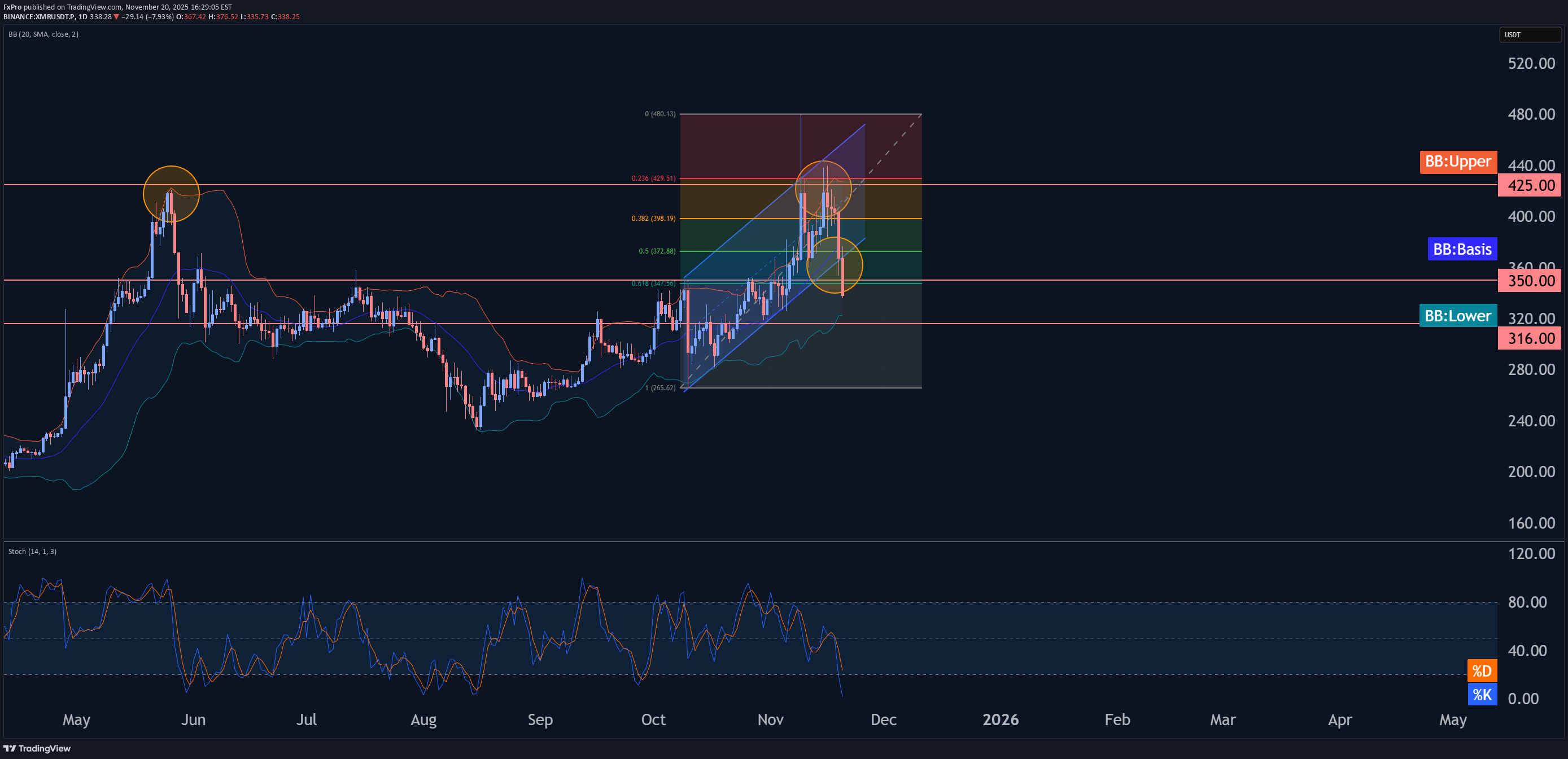
- Monero broke pivotal support level 350.00 - Likely to fall to support level 316.00 Monero cryptocurrency recently broke the pivotal support level 350.00 intersecting with the 61.8% Fibonacci correction of the upward impulse from the start of October. The breakout of the support level 350.00 accelerated the active impulse wave c – which started earlier from the powerful resistance level 425.00. Monero can be expected to fall further to the next support level 316.00, former low of wave iv from the start of November.

The_Traders_House
تحلیل تکنیکال XMR/USDT: آمادهسازی برای فروش کوتاه از حمایت حیاتی 353.53
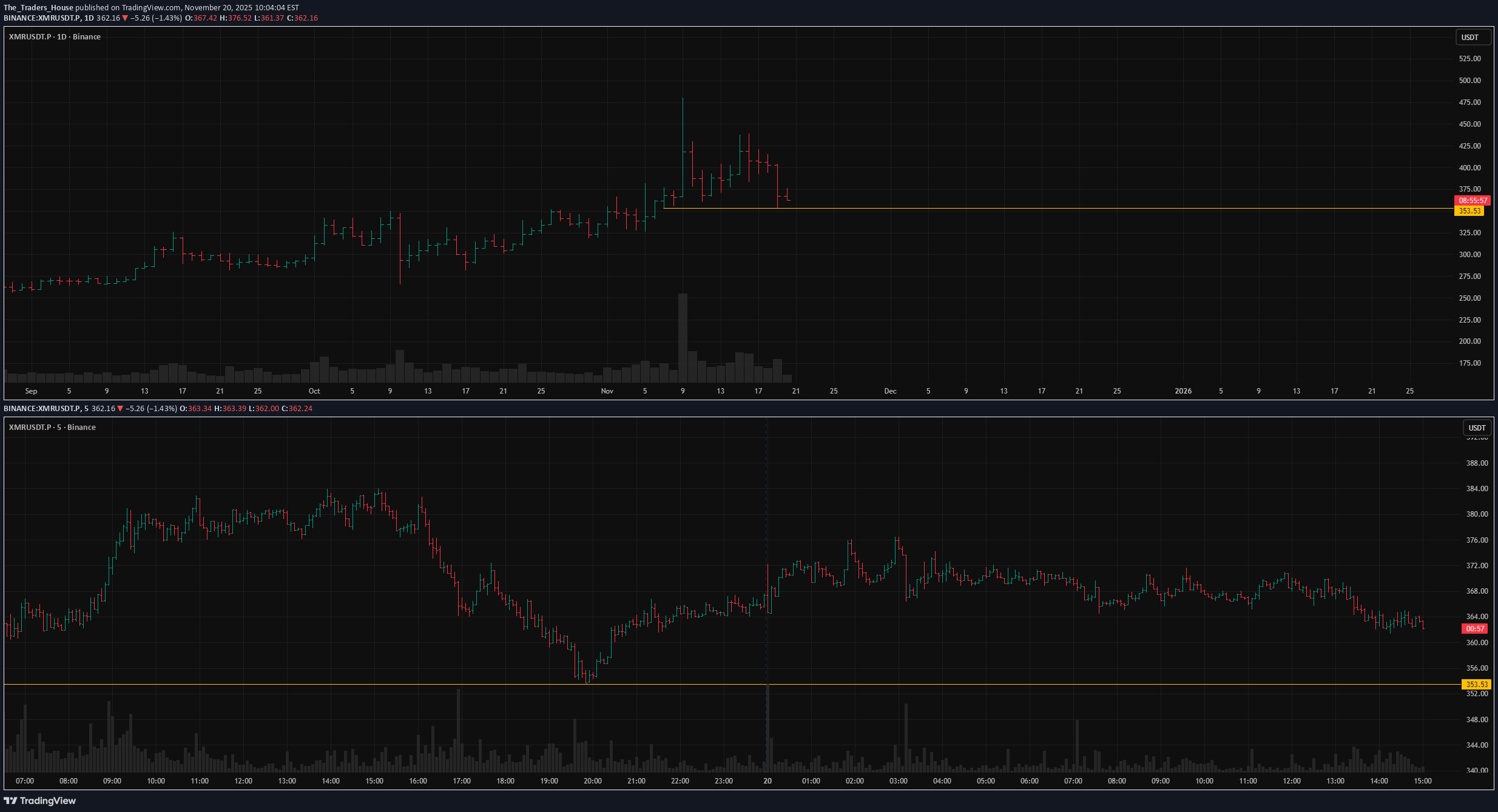
XMRUSDT.P is respecting the 353.53 level very well. Yesterday we saw two bounces, with the correction getting smaller each time. Throughout today, we've seen consolidation above the level with a gradual drift lower. This is a good signal: it suggests the seller is confidently and calmly moving the price in their direction, absorbing the buyers' limit orders along the way. If this type of price action continues right up to the level — that’s ideal. If volatility spikes, it spoils the picture a bit, and we’ll have to watch how the price behaves after the volatility settles. Key factors for this scenario: Volatility contraction on approach Momentum stall at the level Immediate retest Repeated precise tests of the level Consolidation with price compression Closing near the level Closing near the bar's extreme Factors that contradict this scenario: Heavy congestion zone ahead Was this analysis helpful? Leave your thoughts in the comments and follow to see more.
سیگنال خرید XMR/USDT: فرصت طلایی با اهداف سود جذاب (تحلیل تکنیکال قوی)
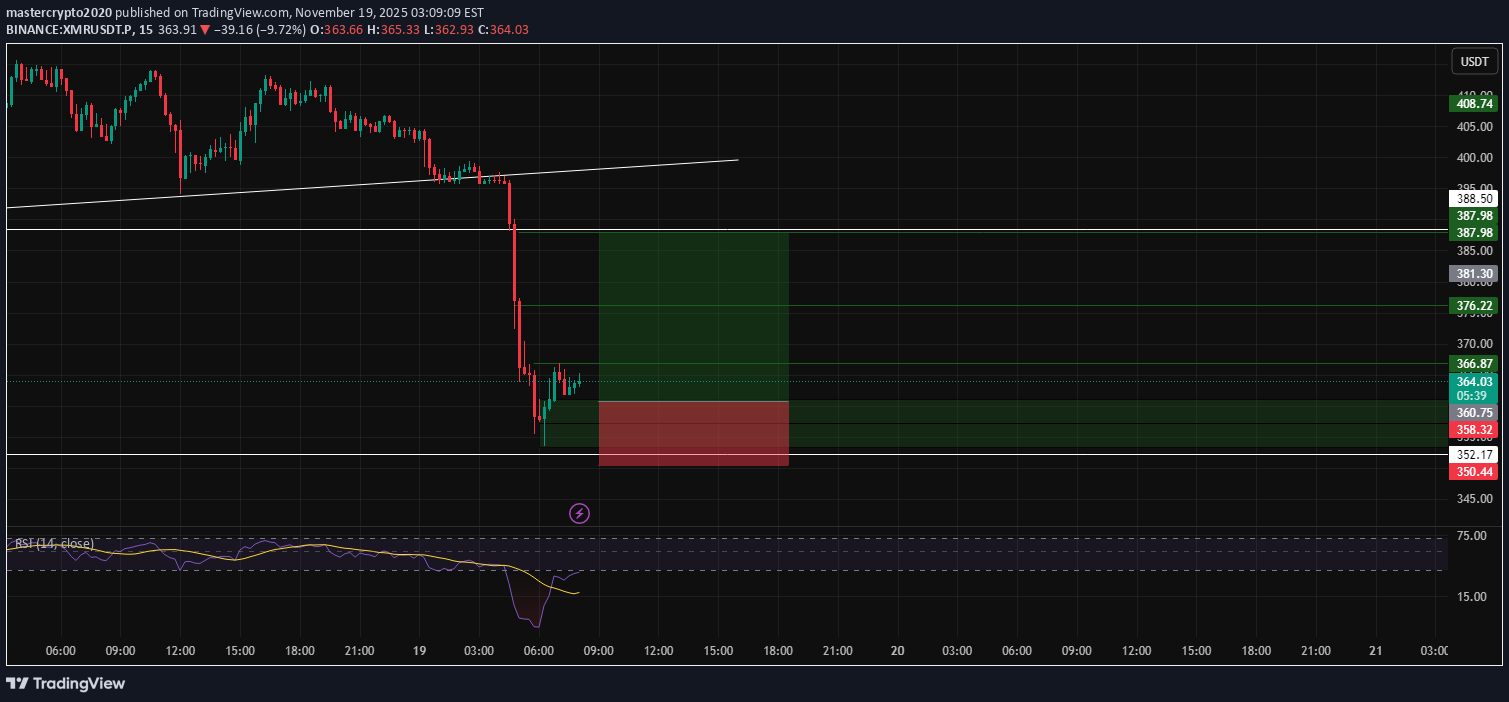
--- 📢 Trade Signal – XMR/USDT 📈 Position Type: Long 💰 Entry Price: 360.75 --- 🎯 Take-Profit Targets (Partial Exits) TP1 = 366.00 TP2 = 376.20 TP3 = 387.95 TP4 = — TP5 = — TP6 = — --- 🛑 Stop-Loss: 350.40 📊 Timeframe: — ⚖️ Risk/Reward Ratio: 2.64 💥 Suggested Leverage: 5× – 10× --- 🧠 Technical Analysis Summary XMR is bouncing strongly from the 350–355 support range, forming a clean bullish short-term structure. The 360.75 entry sits inside an optimal demand zone, with bullish momentum building on lower timeframes. A confirmed break above 366 opens the path toward 376 and 388, where liquidity clusters and major resistance levels sit. Momentum indicators show improving buyer strength. --- ⚙️ Trade Management Take partial profit at TP1 Move Stop-Loss to Break Even after TP1 hits Trail SL as price approaches TP2–TP3 Avoid re-entry if price closes below 350.40 --- ⚠️ Disclaimer This signal is for educational purposes only. Always apply proper risk management. --- 📌 Hashtags for TradingView #XMR #XMRUSDT #CryptoSignal #TradingView #LongSetup #Altcoins #TechnicalAnalysis #FuturesTrading ---

TheCryptoGoon
سیگنال خرید قدرتمند مونرو (XMR/USDT): ورود، تارگتها و استراتژی کامل معامله!
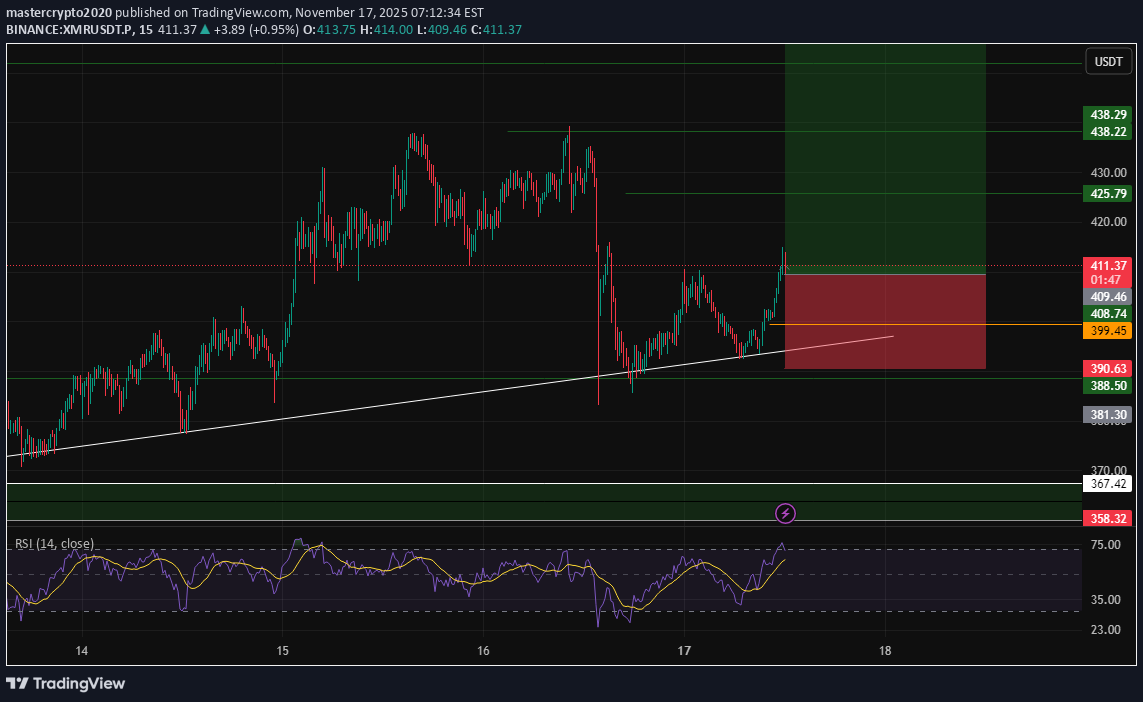
--- 📢 Trade Idea: XMR/USDT Type: Long Entry Zone: 399.84 – 409.38 --- 🎯 Take-Profit Targets (Partial Exits): • TP1 = 425.79 • TP2 = 438.22 • TP3 = 452.33 • TP4 = 467.97 • TP5 = 487.50 • TP6 = — --- 🛑 Stop-Loss: 389.85 ⏱ Timeframe: 15m ⚖️ R/R Ratio: 4.12 💥 Suggested Leverage: 5×–10× --- 🧠 Technical Analysis Summary: XMR is holding strong support inside the 399–409 demand zone, showing bullish reaction and accumulation. Break above 425.7 may trigger momentum toward 438 → 452 → 468, with extended targets near 487. RSI is rising from oversold conditions and the price is reclaiming EMA20/EMA50 — confirming a potential bullish continuation wave. --- ⚙️ Trade Management Tips: • Take partial profit at TP1 and move SL to entry. • From TP2–TP5, use a trailing stop for safety. • Avoid entry if price closes below 389.8. --- ⚠️ Disclaimer: For educational purposes only — manage your capital responsibly. --- 📌 Hashtags for TradingView: #XMRUSDT #Monero #CryptoSignal #TechnicalAnalysis #TradingView #FuturesTrading #Altcoins #CryptoSetup ---

ColdBloodedCharter
مونرو (XMR): راز صعود پنهان RSI و کشف قله جدید قیمت!
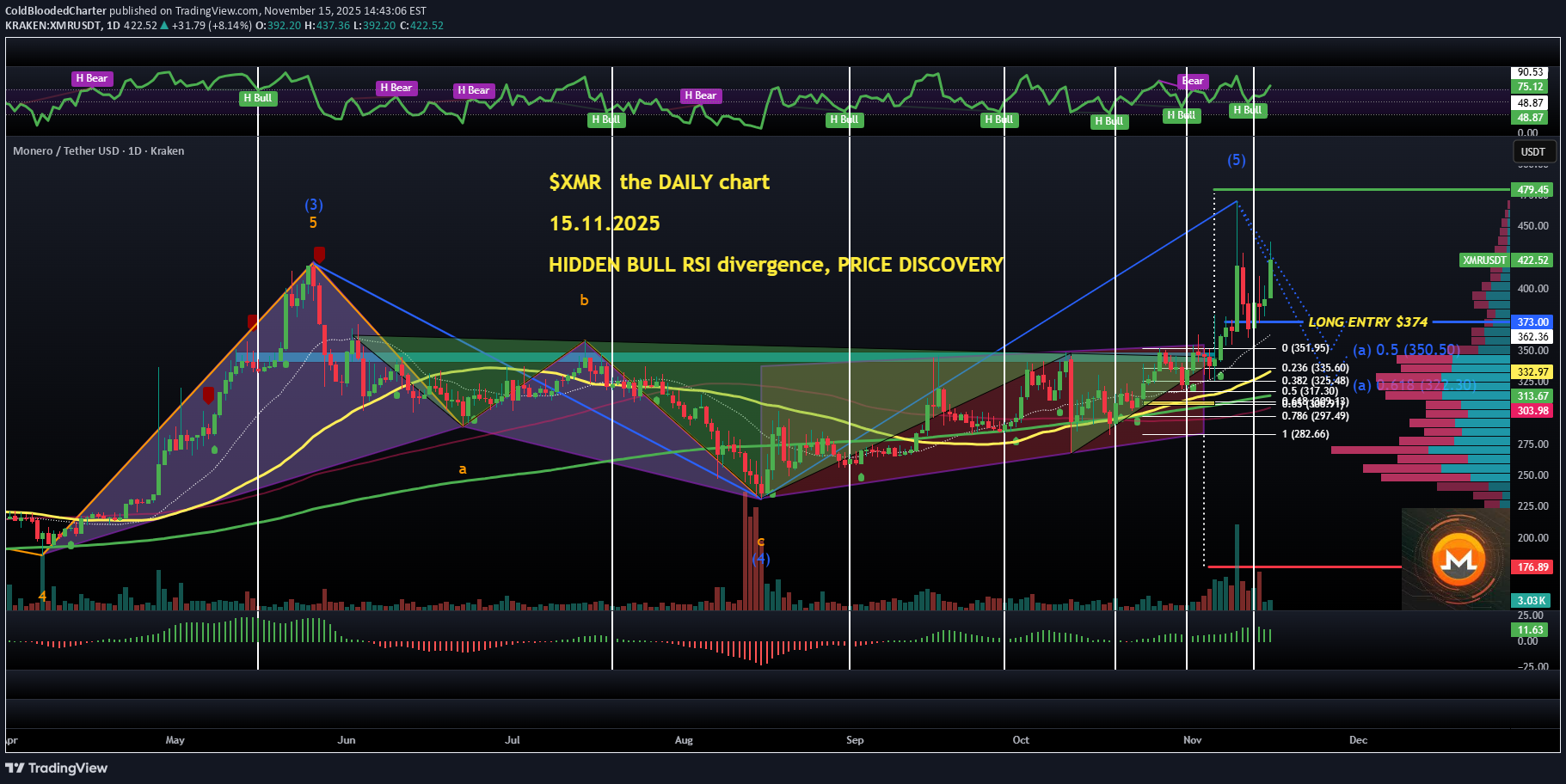
Day 8 in this XMR long position ($374) and obviously this is my only leveraged LONG. My first TP was placed 1% below the INVERTED HEAD&SHOULDERS target ($475) and missed by $5, literally - so unlucky, as the new ATH was established at $470. The DAILY chart is still in WAVE 5 and we've seen yet another HIDDEN BULL RSI divergence (horizontal lines; 5 out of the previous 6 of these divergences led to rallies and RSI crossing above 90). Currently RSI = 75, a bit overbought but with enough room for a solid rally. The 4-HOUR and 8-HOUR charts also show the active WAVE 5 with two most probable targets: $477 and $549. So, my 3 partial TAKE PROFIT levels remain: $475, $544, and a moonbag. STOP LOSS strategy has been adjusted a bit: I'm going to manually close in 3 parts below the 50 MA ($333 atm and rising = a superb dynamic SUPPORT). #Monero is an asset I'm currently the most bullish on - and have been for weeks, as you know. Nothing has changed. 👽💙

pullbacksignal
سیگنال خرید فوری مونرو (XMR): فرصت صعودی جدید با اهداف قیمتی مشخص!

Trading Setup: A Trading Signal is seen in the XMRUSDT Monero (4h) Traders can open their Buy Trades NOW ⬆️Buy now or Buy on 404.0 ⭕️SL @ 375.0 🔵TP1 @ 464.0 🔵TP2 @ 489.9 🔵TP3 @ 537.9 What are these signals based on? Classical Technical Analysis Price Action Candlesticks Fibonacci RSI, Moving Average , Ichimoku , Bollinger Bands Risk Warning Trading Forex, CFDs, Crypto, Futures, and Stocks involve a risk of loss. Please consider carefully if such trading is appropriate for you. Past performance is not indicative of future results. If you liked our ideas, please support us with your likes 👍 and comments .

PraveenTrader1
تحلیل تکنیکال XMR/USDT: فرصت خرید با استفاده از مفاهیم اسمارت مانی (SMC) و پرایس اکشن
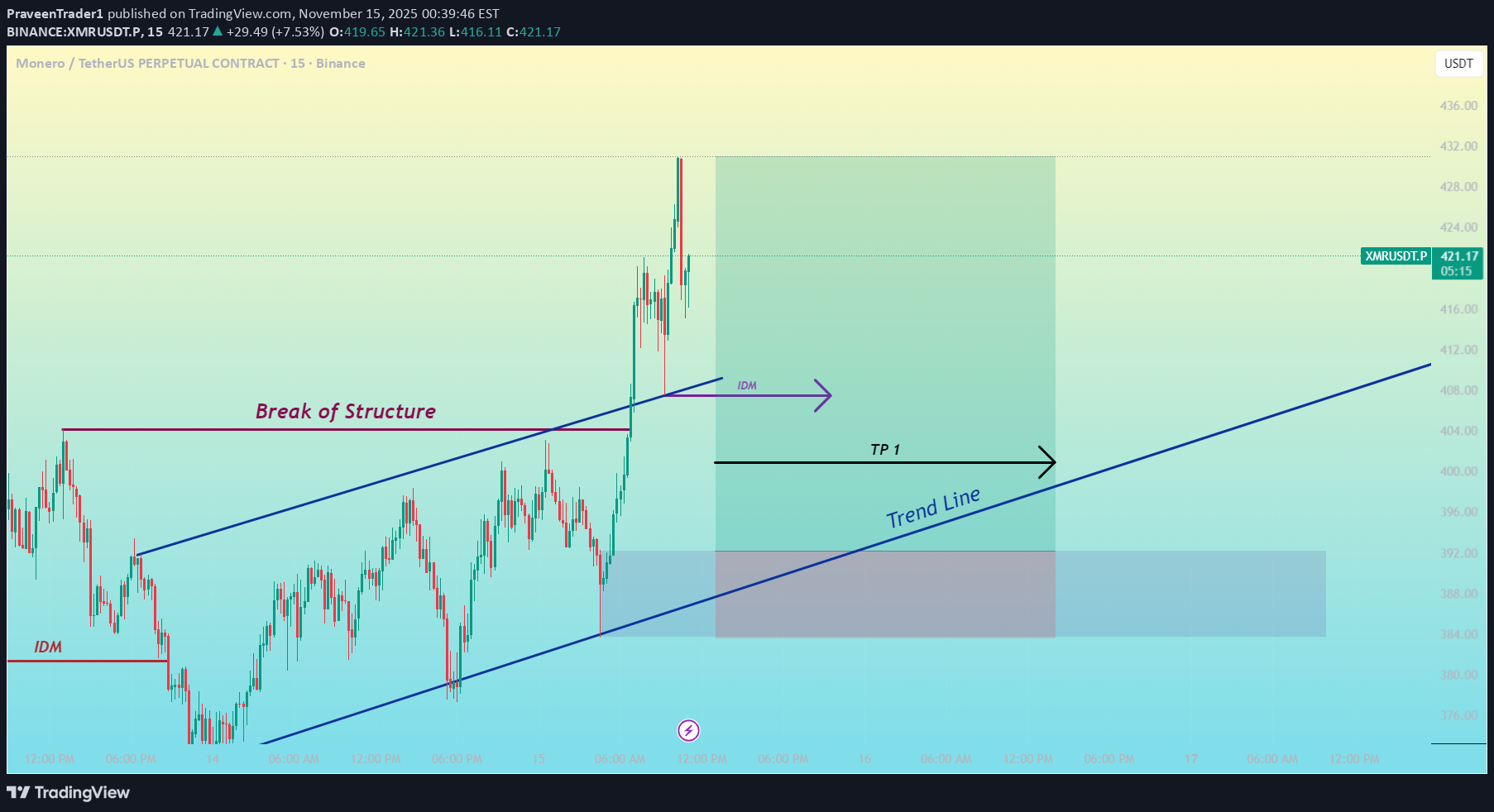
XMRUSDT is clearly in an uptrend, and we already witnessed a strong Break of Structure (BOS). After the BOS, price pulled back into the imbalance (IDM) region, which gives us a high-probability setup in the direction of the trend. The trendline support is holding well, and the market continues to respect higher highs and higher lows. As long as the IDM zone is protected, buyers remain in control. Trade Setup Entry: 391.17 Stop Loss: 483.60 Take Profit 1: 400.87 (1:1 RR) Take Profit 2: 430.99 (4.5 RR) I used Smart Money Concepts (SMC) combined with pure price action, and this setup has a higher probability of playing out in our direction if the entry gets triggered. The overall structure, trendline support, and IDM sweep all align perfectly for a continuation move.
Disclaimer
Any content and materials included in Sahmeto's website and official communication channels are a compilation of personal opinions and analyses and are not binding. They do not constitute any recommendation for buying, selling, entering or exiting the stock market and cryptocurrency market. Also, all news and analyses included in the website and channels are merely republished information from official and unofficial domestic and foreign sources, and it is obvious that users of the said content are responsible for following up and ensuring the authenticity and accuracy of the materials. Therefore, while disclaiming responsibility, it is declared that the responsibility for any decision-making, action, and potential profit and loss in the capital market and cryptocurrency market lies with the trader.

